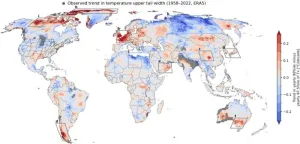(Press-News.org) A team of researchers led by Anna-Karin Gustavsson at Rice University has developed an innovative imaging platform that promises to improve our understanding of cellular structures at the nanoscale. This platform, called soTILT3D for single-objective tilted light sheet with 3D point spread functions (PSFs), offers significant advancements in super-resolution microscopy, enabling fast and precise 3D imaging of multiple cellular structures while the extracellular environment can be controlled and flexibly adjusted. The research was recently published in Nature Communications.
Studying cells at the nanoscale provides insights into the intricate mechanisms that drive cellular behavior, enabling researchers to uncover details that are essential for understanding health and disease. These details can reveal how molecular interactions contribute to cellular functions, which is critical for advancing targeted therapies and understanding disease pathogenesis.
While conventional fluorescence microscopy has been useful for studying cellular structures, it has been limited by the diffraction of light, restricting its ability to resolve features smaller than a few hundred nanometers. Moreover, while single-molecule super-resolution microscopy has provided groundbreaking insights into biological structures at the nanoscale, existing techniques often suffer from high background fluorescence and slow imaging speeds, particularly when dealing with thick samples or complex cell aggregates. They also typically lack precise, adjustable control of the sample environment.
The soTILT3D platform directly addresses these challenges. By synergistically integrating an angled light sheet, a nanoprinted microfluidic system and advanced computational tools, soTILT3D significantly improves imaging precision and speed, allowing for clearer visualization of how different cellular structures interact at the nanoscale — even in conventionally challenging samples.
Key innovations
The soTILT3D platform uses a single-objective tilted light sheet to selectively illuminate thin slices of a sample, effectively enhancing the contrast by reducing background fluorescence from out-of-focus areas, especially in thick biological samples such as mammalian cells.
“The light sheet is formed using the same objective lens as used in the microscope for imaging, and it is fully steerable, dithered to remove shadowing artifacts that are common in light sheet microscopy and angled to enable imaging all the way down to the coverslip,” said Gustavsson, assistant professor of chemistry at Rice and corresponding author of the study. “This allows us to image entire samples from top to bottom with improved precision.”
The platform also incorporates a custom-designed microfluidic system with an embedded customizable metalized micromirror, which enables precise control over the extracellular environment and allows for rapid solution exchange, which is ideal for sequential multitarget imaging without color offsets while also allowing for reflection of the light sheet into the sample.
“The design and geometry of the microfluidic chip and nanoprinted insert with the micromirror can be easily adapted for various samples and length scales, providing versatility in different experimental setups,” said Nahima Saliba, co-first author of the paper alongside fellow graduate student Gabriella Gagliano, who is also associated with the Smalley-Curl Institute and the Applied Physics Graduate Program at Rice.
Additionally, soTILT3D leverages computational tools such as deep learning for analysis of higher fluorophore concentrations for improved imaging speed and algorithms for real-time drift correction, enabling stable, high-precision imaging over extended periods of time.
“The platform’s PSF engineering enables 3D imaging of single molecules, while deep learning handles dense emitter conditions which conventional algorithms have trouble with, which significantly improves the acquisition speed,” said Saliba.
SoTILT3D’s microfluidic device also supports automated Exchange-PAINT imaging, allowing different targets to be visualized sequentially without the color offsets common in multicolor approaches when imaging in-depth at the nanoscale.
Groundbreaking results
The soTILT3D platform has demonstrated remarkable improvements in imaging precision and speed. The platform’s angled light sheet improves the signal-to-background ratio for cellular imaging by up to six times compared to traditional epi-illumination methods, improving contrast and enabling precise nanoscale localization.
“This level of detail reveals intricate aspects of 3D cell architecture that have been traditionally difficult to observe with conventional approaches,” said Gagliano.
In terms of speed, soTILT3D delivers a tenfold increase when combined with high emitter density and deep learning analysis, allowing researchers to capture detailed images of complex structures like the nuclear lamina, mitochondria and cell membrane proteins across entire cells in a fraction of the usual time. Additionally, the platform supports accurate whole-cell 3D multitarget imaging, capturing the distributions of multiple proteins within an entire cell and measuring nanoscale distances between them. Researchers can now visualize the spatial arrangement of closely situated proteins like nuclear lamina proteins lamin B1 and lamin A/C and lamina-associated protein 2 with remarkable precision and accuracy, offering new insights into protein organizations and their role in regulating cellular function.
Broad applications in biology and medicine
The soTILT3D platform opens new possibilities for researchers across various fields. Its capability to image complex samples, including stem cell aggregates, extends its application beyond individual cells. The microfluidic system’s biocompatibility makes it suitable for live-cell imaging, allowing scientists to study cellular responses to different stimuli in real time with reduced photo damage. Its precisely controlled solution exchange feature also makes soTILT3D an ideal tool for testing how drug treatments affect cells in real time.
“Our goal with soTILT3D was to create a flexible imaging tool that overcomes limitations of traditional super-resolution microscopy,” said Gustavsson. “We hope these advancements will enhance studies in biology, biophysics and biomedicine, where intricate interactions at the nanoscale are key to understanding cellular function in health and pathogenesis.”
This research was supported by partial financial support from the National Institute of General Medical Sciences of the National Institutes of Health grant R00GM134187 and grant R35GM155365, the Welch Foundation grant C-2064-20210327 and startup funds from the Cancer Prevention and Research Institute of Texas grant RR200025.
END
New imaging platform developed by Rice researchers revolutionizes 3D visualization of cellular structures
Improvements in super-resolution microscopy have wide-ranging implications for biological and biomedical research
2024-11-26
ELSE PRESS RELEASES FROM THIS DATE:
To catch financial rats, a better mousetrap
2024-11-26
Enron. Lehman Brothers. More recently, General Electric and Supermicro. During the past quarter century, a variety of high-profile companies have been caught cooking their books.
But they’re often not caught before they’ve cost investors billions of dollars. That’s why analysts have long tried to sniff out businesses that may be using questionable or flat-out illegal accounting tricks to hide poor performance.
New research from Urooj Khan, accounting professor and the Deloitte & Touche Centennial Faculty Fellow at Texas McCombs, proposes a new and more effective way to gauge companies’ “earnings quality.”
In analyses of corporate ...
Mapping the world's climate danger zones
2024-11-26
With 2024 on track to be declared the hottest on record, scientists from IIASA and Columbia University have noticed that specific regions are consistently more affected by extreme temperatures. A new study provides the first worldwide map of these regional climate danger zones.
Amid the continued upward march in average temperatures over the past decades, a recent surge of record shattering extreme heat waves raise questions about the degree to which climate models can provide adequate estimates of relations between global mean temperature changes and regional climate risks. The study just published in the Proceedings of the National Academy of Sciences (PNAS) provides the ...
Emory heart team implants new blood-pumping device for first time in U.S.
2024-11-26
On Nov. 18, the heart failure and transplantation team at Emory University Hospital (EUH) made history, performing the first-ever surgical implantation in the United States of a brand-new type of ventricular assist device (VAD), which provides crucial care to patients with failing hearts.
An expert team led by veteran cardiothoracic surgeon Mani Daneshmand, MD, successfully implanted a novel magnetically levitated pump, a VAD that has been specifically designed for patient ease and long-term health. The BrioVAD System, made by BrioHealth Solutions Inc., was authorized by the FDA to begin clinical trials ...
Congenital heart defects caused by problems with placenta
2024-11-26
Congenital heart defects are the most common form of human birth defect, but we still don’t fully understand what causes them. Previous research had suggested that some heart defects could be triggered by problems with the placenta, the organ that provides oxygen and nutrients to the developing embryo. Now, researchers at Nanjing University, China have confirmed this link by focusing on a protein whose levels are reduced in many patients with congenital heart defects, called SLC25A1. SLC25A1 plays a key role in transporting ...
Schlechter named Cancer Moonshot Scholar
2024-11-26
Chelsey Schlechter, MPH, PhD, Huntsman Cancer Institute investigator and assistant professor in the Department of Population Health Sciences at the University of Utah (the U), has been selected as a Cancer Moonshot Scholar.
Schlechter is one of only eleven researchers in the U.S. chosen for the prestigious program this year, which aims to both advance impactful cancer research and broaden the research workforce.
For the project, Schlechter and her team partnered with the Association for Utah Community Health and Utah Community Health Centers—organizations which ...
Two-way water transfers can ensure reliability, save money for urban and agricultural users during drought in Western U.S., new study shows
2024-11-26
A new study led by researchers at the University of North Carolina at Chapel Hill offers a solution to water scarcity during droughts amid the tug of economic development, population growth and climate uncertainty for water users in Western U.S. states. The proposed two-way leasing contracts would coordinate agricultural-to-urban leasing during periods of drought and urban-to-agricultural leasing during wet periods, benefiting both urban and agricultural water users.
“Water markets are an important tool for allocating water in the Western U.S., and other water-scarce regions around the world, but they are often slow to respond to drought, ...
New issue of advances in dental research explores the role of women in dental, clinical, and translational research
2024-11-26
Alexandria, VA, USA - The Journal of Dental Research (JDR) has announced the publication of a new issue of Advances in Dental Research, a supplement to the Journal of Dental Research (JDR), entitled, "Women in Dental, Clinical, and Translational Research.”
The 2024 Annual Meeting of the American Association for Dental, Oral, and Craniofacial Research (AADOCR) and the Canadian Association for Dental Research featured a two-day “Meeting Within a Meeting” on the topic of “Women in Dental, Clinical, and Translational Research” organized by AADOCR Then- President Alexandre Vieira. During these sessions, speakers were challenged to reflect on ...
Team unlocks new insights on pulsar signals
2024-11-26
Team Unlocks New Insights on Pulsar Signals
November 26, 2024, Mountain View, CA – Dr. Sofia Sheikh from the SETI Institute led a study that sheds new light on how pulsar signals—the spinning remnants of massive stars—distort as they travel through space. This study, published in The Astrophysical Journal, was performed by a multi-year cohort of undergraduate researchers in the Penn State branch of the Pulsar Search Collaboratory student club. Maura McLaughlin, Chair, Eberly Distinguished Professor of Physics and Astronomy, West Virginia University, created the Pulsar Search Collaboratory to engage ...
Great apes visually track subject-object relationships like humans do
2024-11-26
Great apes track events with their eyes in the same way that humans do, according to a study published November 26th in the open-access journal PLOS Biology by Vanessa Wilson from the University of Neuchatel, Switzerland, and colleagues.
When watching a cat chase a mouse, humans will alternate looking at cat and mouse, using the information to connect the two into what’s called an agent-patient relationship—with the cat as the agent and the mouse as the patient. This cognitive mechanism is thought to be ...
Recovery of testing for heart disease risk factors post-COVID remains patchy
2024-11-26
Routine screening to detect risk factors for heart disease dropped sharply during the COVID-19 pandemic in England, and some key measurements, such as blood pressure readings, may still lag behind pre-pandemic levels. These findings are reported in a new study by Frederick Ho and Naveed Sattar of the University of Glasgow, Scotland, UK, and colleagues published November 26th in the open-access journal PLOS Medicine.
During the COVID-19 pandemic, patients went without routine face-to-face health checks, which are important for detecting common cardiometabolic ...
LAST 30 PRESS RELEASES:
Why nail-biting, procrastination and other self-sabotaging behaviors are rooted in survival instincts
Regional variations in mechanical properties of porcine leptomeninges
Artificial empathy in therapy and healthcare: advancements in interpersonal interaction technologies
Why some brains switch gears more efficiently than others
UVA’s Jundong Li wins ICDM’S 2025 Tao Li Award for data mining, machine learning
UVA’s low-power, high-performance computer power player Mircea Stan earns National Academy of Inventors fellowship
Not playing by the rules: USU researcher explores filamentous algae dynamics in rivers
Do our body clocks influence our risk of dementia?
Anthropologists offer new evidence of bipedalism in long-debated fossil discovery
Safer receipt paper from wood
Dosage-sensitive genes suggest no whole-genome duplications in ancestral angiosperm
First ancient human herpesvirus genomes document their deep history with humans
Why Some Bacteria Survive Antibiotics and How to Stop Them - New study reveals that bacteria can survive antibiotic treatment through two fundamentally different “shutdown modes”
UCLA study links scar healing to dangerous placenta condition
CHANGE-seq-BE finds off-target changes in the genome from base editors
The Journal of Nuclear Medicine Ahead-of-Print Tip Sheet: January 2, 2026
Delayed or absent first dose of measles, mumps, and rubella vaccination
Trends in US preterm birth rates by household income and race and ethnicity
Study identifies potential biomarker linked to progression and brain inflammation in multiple sclerosis
Many mothers in Norway do not show up for postnatal check-ups
Researchers want to find out why quick clay is so unstable
Superradiant spins show teamwork at the quantum scale
Cleveland Clinic Research links tumor bacteria to immunotherapy resistance in head and neck cancer
First Editorial of 2026: Resisting AI slop
Joint ground- and space-based observations reveal Saturn-mass rogue planet
Inheritable genetic variant offers protection against blood cancer risk and progression
Pigs settled Pacific islands alongside early human voyagers
A Coral reef’s daily pulse reshapes microbes in surrounding waters
EAST Tokamak experiments exceed plasma density limit, offering new approach to fusion ignition
Groundbreaking discovery reveals Africa’s oldest cremation pyre and complex ritual practices
[Press-News.org] New imaging platform developed by Rice researchers revolutionizes 3D visualization of cellular structuresImprovements in super-resolution microscopy have wide-ranging implications for biological and biomedical research





